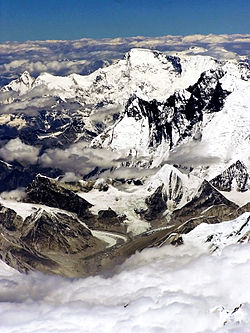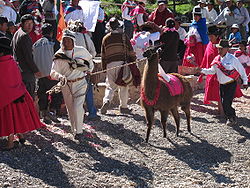High-altitude adaptation in humans
High-altitude adaptation in humans is an instance of
Around 81.6 million humans (approximately 1.1% of the world's human population) live permanently at altitudes above 2,500 meters (8,200 ft),[4] which would seem to put these populations at risk for chronic mountain sickness (CMS).[1] However, the high-altitude populations in South America, East Africa, and South Asia have lived there for millennia without apparent complications.[5] This special adaptation is now recognized as an example of natural selection in action.[6] The adaptation of the Tibetans is the fastest known example of human evolution, as it is estimated to have occurred between 1,000 BCE[7][8][9] to 7,000 BCE.[10][11]
Origin and basis

The sickness is compounded by related symptoms such as
An estimated 81.6 million humans live at an elevation higher than 2,500 meters (8,200 ft) above sea level, of which 21.7 million reside in
One of the best-documented effects of high altitude on non-adapted women is a progressive reduction in birth weight. By contrast, the women of long-resident, high-altitude populations are known to give birth to heavier-weight infants than women of the lowland. This is particularly true among Tibetan babies, whose average birth weight is 294–650g (~470) g heavier than the surrounding Chinese population, and their blood-oxygen level is considerably higher.[24]
Scientific investigation of high-altitude adaptation was initiated by A. Roberto Frisancho of the University of Michigan in the late 1960s among the Quechua people of Peru.[25][26] Paul T. Baker of Penn State University’s Department of Anthropology also conducted a considerable amount of research into human adaptation to high altitudes, and mentored students who continued this research.[27] One of these students, anthropologist Cynthia Beall of Case Western Reserve University, began conducting decades-long research on high altitude adaptation among the Tibetans in the early 1980s.[28]
Physiological basis
Among the different native highlander populations, the underlying physiological responses to adaptation differ. For example, among four quantitative features, such as resting ventilation, hypoxic ventilatory response, oxygen saturation, and hemoglobin concentration, the levels of variations are significantly different between the Tibetans and the Aymaras.[29] Methylation also influences oxygenation.[30]
Tibetans

In the early 20th century, researchers observed the impressive physical abilities of Tibetans during Himalayan climbing expeditions. They considered the possibility that these abilities resulted from an evolutionary genetic adaptation to high-altitude conditions.
Tibetans who have been living in the Chantong-Qingnan area for 3,000 years do not exhibit the same elevated hemoglobin concentrations to cope with oxygen deficiency that are observed in other populations who have moved temporarily or permanently to high altitudes. Instead, the Tibetans inhale more air with each breath and breathe more rapidly than either sea-level populations or Andeans. Tibetans have better
With the proper physical preparation, individuals can develop short-term tolerance to high-altitude conditions. However, these biological changes are temporary and will reverse upon returning to lower elevations.[35] Moreover, while lowland people typically experience increased breathing for only a few days after entering high altitudes, Tibetans maintain this rapid breathing and elevated lung capacity throughout their lifetime.[36] This enables them to inhale large amounts of air per unit of time to compensate for low oxygen levels. Additionally, Tibetans typically have significantly higher levels of nitric oxide in their blood, often double that of lowlanders. This likely contributes to enhanced blood circulation by promoting vasodilation.[37]
Furthermore, their hemoglobin level is not significantly different (average 15.6 g/dl in males and 14.2 g/dl in females)[38] from those of humans living at low altitude. This is evidenced by mountaineers experiencing an increase of over 2 g/dl in hemoglobin levels within two weeks at the Mt. Everest base camp.[39] Consequently, Tibetans demonstrate the capacity to mitigate the effects of hypoxia and mountain sickness throughout their lives. Even when ascending extraordinarily high peaks such as Mount Everest, they exhibit consistent oxygen uptake, heightened ventilation, augmented hypoxic ventilatory responses, expanded lung volumes, increased diffusing capacities, stable body weight, and improved sleep quality compared to lowland populations.[40]
Andeans
In contrast to the Tibetans, Andean highlanders show different patterns of hemoglobin adaptation. Their hemoglobin concentration is higher than those of the lowlander population, which also happens to lowlanders who move to high altitudes. When they spend some weeks in the lowlands, their hemoglobin drops to the same levels as lowland humans. However, in contrast to lowland humans, they have increased oxygen levels in their hemoglobin; that is, more oxygen per blood volume. This confers an ability to carry more oxygen in each red blood cell, meaning a more effective transport of oxygen throughout their bodies.

Among the Quechua people of the

Ethiopians
The people of the
Genetic basis
The underlying molecular evolution of high-altitude adaptation has been explored in recent years.[23] Depending on geographical and environmental pressures, high-altitude adaptation involves different genetic patterns, some of which have evolved not long ago. For example, Tibetan adaptations became prevalent in the past 3,000 years, an example of rapid recent human evolution. At the turn of the 21st century, it was reported that the genetic makeup of the respiratory components of the Tibetan and the Ethiopian populations were significantly different.[29]
Tibetans
Substantial evidence from Tibetan highlanders suggests that variation in hemoglobin and blood-oxygen levels are adaptive as Darwinian fitness. It has been documented that Tibetan women with a high likelihood of possessing one to two alleles for high blood-oxygen content (which is rare in other women) had more surviving children; the higher the oxygen capacity, the lower the infant mortality.[52] In 2010, for the first time, the genes responsible for the unique adaptive traits were identified following genome sequencing of 50 Tibetans and 40 Han Chinese from Beijing. Initially, the strongest signal of natural selection was a transcription factor involved in response to hypoxia, called endothelial Per-Arnt-Sim (PAS) domain protein 1 (EPAS1). It was found that one single-nucleotide polymorphism (SNP) at EPAS1 shows a 78% frequency difference between Tibetan and mainland Chinese samples, representing the fastest genetic change observed in any human gene to date. Hence, Tibetan adaptation to high altitude is recognized as one of the fastest processes of phenotypically observable evolution in humans,[53] which is estimated to have occurred a few thousand years ago, when the Tibetans split from the mainland Chinese population. The time of genetic divergence has been variously estimated as 2,750 (original estimate),[9] 4,725,[11] 8,000,[54] or 9,000[10] years ago.
Similarly, the
The genes EPAS1, EGLN1, and PPARA function in concert with another gene named
Among the Tibetans, a mutation in EGLN1 (specifically at position 12, where cytosine is replaced with guanine; and at 380, where G is replaced with C) results in mutant PHD2 (aspartic acid at position 4 becomes glutamine, and cysteine at 127 becomes serine) and this mutation inhibits erythropoiesis. This mutation is estimated to have occurred approximately 8,000 years ago.
Andeans
The patterns of genetic adaptation among the Andeans are largely distinct from those of the Tibetans, with both populations showing evidence of positive natural selection in different genes or gene regions. For genes in the HIF pathway, EGLN1 is the only instance where evidence of positive selection is observed in both Tibetans and Andeans.[66] Even then, the pattern of variation for this gene differs between the two populations.[6] Furthermore, there are no significant associations between EPAS1 or EGLN1 SNP genotypes and hemoglobin concentration among the Andeans, which is characteristic of the Tibetans.[67]
The Andean pattern of adaptation is characterized by selection in a number of genes involved in cardiovascular development and function (such as BRINP3, EDNRA, NOS2A).[68][69] This suggests that selection in Andeans, instead of targeting the HIF pathway like in the Tibetans, focused on adaptations of the cardiovascular system to combat chronic disease at high altitude. Analysis of ancient Andean genomes, some dating back 7,000 years, discovered selection in DST, a gene involved in cardiovascular function.[70] The whole genome sequences of 20 Andeans (half of them having chronic mountain sickness) revealed that two genes, SENP1 (an erythropoiesis regulator) and ANP32D (an oncogene) play vital roles in their weak adaptation to hypoxia.[71]
Ethiopians
The adaptive mechanism of Ethiopian highlanders differs from those of the Tibetans and Andeans due to the fact that their migration to the highland was relatively early. For example, the
See also
- Altitude
- acclimatisation)
- High-altitude adaptation
- High-altitude football controversy
- Tibetan Plateau
References
- ^ S2CID 24949046.
- ^ ISBN 978-0472095117.
- ^ Hillary Mayell (24 February 2004). "Three High-Altitude Peoples, Three Adaptations to Thin Air". National Geographic News. National Geographic Society. Archived from the original on March 30, 2021. Retrieved 1 September 2013.
- ^ PMID 33903258.
- ^ PMID 11443005.
- ^ PMID 20838600.
- ^ Sanders R (1 July 2010). "Tibetans adapted to high altitude in less than 3,000 years". News Centre, UC Berkeley. UC Regents. Retrieved 2013-07-08.
- ^ Hsu J (1 July 2010). "Tibetans Underwent Fastest Evolution Seen in Humans". Live Science. TechMediaNetwork.com. Retrieved 2013-07-08.
- ^ PMID 20595611.
- ^ PMID 28448578.
- ^ PMID 28373541.
- .
- S2CID 30489799.
- ^ PMID 17339571.
- PMID 20417348.
- S2CID 12821635.
- PMID 23580834.
- S2CID 46056757.
- PMID 11950141.
- PMID 19074222.
- PMID 15033310.
- ^ ISBN 978-0824746049.
- ^ ISBN 978-0521879484.
- PMID 7566001.
- PMID 5372293.
- S2CID 41568762.
- ^ "Paul Baker". www.nasonline.org. Retrieved 2018-10-16.
- S2CID 42661256.
- ^ PMID 10721618.
- S2CID 234398150.
- PMID 16978132.
- PMID 11809089.
- PMID 9881522.
- PMID 11443005.
- PMID 20586592.
- ^ PMID 17494744.
- PMID 22300645.
- ^ S2CID 5692192.
- PMID 17344565.
- PMID 15813148.
- S2CID 33055072.
- PMID 20367485.
- S2CID 11768057.
- PMID 22552823.
- PMID 7337418.
- PMID 4061583.
- S2CID 158629.
- PMID 10849649.
- PMID 21672719.
- PMID 12471159.
- PMID 18096845.
- PMID 15353580.
- ^ Native Village Youth; Education news (May 2011). "Tibetans evolved at fastest pace ever measured". Archived from the original on November 2, 2014. Retrieved 2013-04-15.
- PMID 25129147.
- S2CID 45471238.
- PMID 23227185.
- PMID 25043035.
- PMID 21030426.
- PMID 24513612.
- PMID 21718161.
- PMID 21718164.
- S2CID 17636832.
- PMID 22503288.
- PMID 25129147.
- PMID 22844521.
- PMID 20838600.
- S2CID 1900321.
- PMID 20038496.
- PMID 29100088.
- PMID 30417096.
- PMID 23954164.
- S2CID 162259548.
- PMID 23236293.
- PMID 22264333.
External links
- Adapting to High Altitude Archived 2013-01-06 at the Wayback Machine
- High Altitude and Cold: Adaptation to the extremes Archived 2016-03-04 at the Wayback Machine
- Understanding adaptation to high altitude in the Andean region Archived 2016-03-03 at the Wayback Machine
- BBC: Altitude tolerant
- Understanding Evolution: The mysteries of Tibet
- Scientific resources at the Center for Research on Tibet
- Evolutionary Adaptations in High Altitude Tibet Archived 2012-09-27 at the Wayback Machine
- The Challenge of Living at High Altitudes
- Adapting to High Altitude Archived 2013-03-06 at the Wayback Machine
